Cafe Society: Hydro Tasmania’s Chris Gwynne is bursting with energy about the Battery of the Nation project he leads
Hydro Tasmania’s Chris Gwynne is bursting with energy about Battery of the Nation project.

Tasmania
Don't miss out on the headlines from Tasmania. Followed categories will be added to My News.
TASMANIA is poised for electrifying change when I meet Hydro Tasmania’s Chris Gwynne at Cafe Lola, a stone’s throw from his workplace near the Hobart waterfront.
Over the past two years, the Battery of the Nation project director has travelled widely talking up the benefits of introducing a pumped-hydro, renewable-energy storage system in the state.
He shows no signs of flagging this morning, predicting Tasmania will play a crucial role in the country’s conversion from coal-fired generation to renewables.
Chris says there’s no time to waste if Tasmania is to play to its strengths to snag a bigger slice of the national energy market.
MORE CAFE SOCIETY:
DAVID LEE: ANOTHER WAY OF LOOKING AT HIGHRISE
ROBERT MORRIS-NUNN: VISION OF LIFE ON THE WATER
MEZ NEWMAN: IS THIS THE WAY TO SOLVE HOUSING CRISIS?
KATRENA STEPHENSON: COUNCILLORS’ CONFLICTING DEMANDS
PAUL BLACKLOW: IT’S TIME TO SPLASH THE CASH

“Billions of dollars of investment are pouring into wind and solar generation in Australia and all the major investment houses are clearly indicating there are too many risks involved in investing in coal-fired generation,” he says, noting the Federal Govern-ment is providing most of the money for the Tassie push.

He says the economic opportunity is among the most significant for the state in decades.
“We were an economy predominantly built on the back of our hydropower system … and that’s a great starting point for the future,” he says.
As renewables interest surges in response to climate change, Tasmania is ahead of the curve, with hydro providing up to 90 per cent of the state’s electricity.
“We don’t just have the natural resources, we have the highly skilled and highly experienced people with the capacity to design that new future,” says Chris.
But we cannot capitalise on our clever people or abundant wind, sunshine and water without more interconnectors such as Basslink to turbocharge connectivity with the mainland, he says.
While the Morrison Government has committed $56 million to progress a second Bass Strait interconnector, it has not yet committed infrastructure funding.
Chris predicts major expansion of wind farms, in particular, if the second interconnector, Marinus Link, is funded. But even that would be early days in his mind.
His view is that “three or four or five” cables could be laid over the next 10-25 years, with an export capacity to unlock more large-scale renewable energy.

“We wouldn’t just go out and build a whole bunch of pumped hydro projects unless we knew the connections to the markets in Victoria and NSW were there,” he says.
“Each cable you put in triggers more wind develop-ment, because you have more access to those markets that need that new energy.
“And for us here at Hydro that then triggers more opportunities to do the next pumped hydro project.” Of all Hydro’s stated objectives with pumped hydro — that include enhanced energy security and the “lowest possible power prices” for the state — it is unlocking renewable energy potential for the whole country that seems to excite Chris most.
“At a national level, even a global level, if we want to turn off coal-fired generation in the long term, and we want to reduce carbon emissions from our electricity sector, we have to change,” he says.
“It’s now up to us as the community to have the conversations. My personal view is that we need to lift our gaze from just being Tasmanians to seeing what we can contribute to solving what is a global problem.”
Unlike Tasmania’s traditional hydro system, pumped hydro’s primary value is not generation but storage capacity. It’s a crucial difference which, once understood, explains why using electricity to pump water uphill only to release it again to generate electricity is not as silly as it first sounds.
With coal-fired power, managing supply and demand is simple. You just keep digging coal, stockpiling it and feeding the fire for quick electricity.
“The challenge with wind and solar is that you can’t control it like that,” says Chris.
“When the sun shines and the wind blows, you get a massive influx of energy into the system, but that may not be the point in time that people want to use electricity.”
Pumped hydro, like grid-connected chemical batteries, lends renewables a fossil-fuels level of availability, reliability and flexibility. And that’s why it is game-changing.
Traditional hydro is a flow-through system, but pumped hydro is a closed loop system with two reservoirs at different heights that can be manipulated to store latent energy. It works by feeding excess wind and solar harvested into hydro plants to pump water uphill to be gravity-stored until it’s needed. Then, whoosh!
It all sounds very logical, but not everyone loves a wind farm, I say, and not everyone will love a bold Hydro plan, given lingering damnation of Hydro over the flooding of Lake Pedder in 1972 and the Franklin Dam controversy in the early 1980s.
“We’re very pleased with the work we are doing, but the community needs to support and want the opportunity that this will open up,” says Chris.
“If they don’t, well, then there’s a disconnect that we will need to resolve as a state.”


